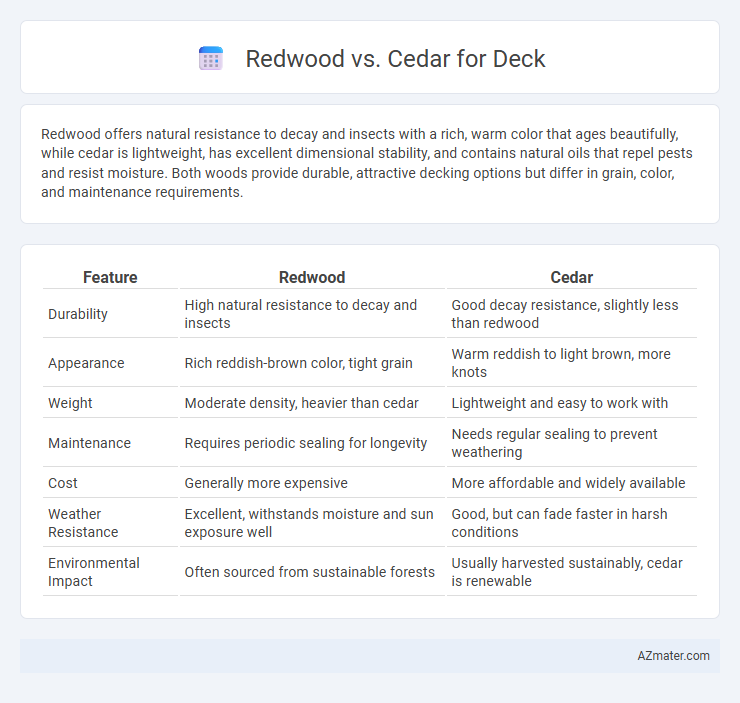Redwood offers natural resistance to decay and insects with a rich, warm color that ages beautifully, while cedar is lightweight, has excellent dimensional stability, and contains natural oils that repel pests and resist moisture. Both woods provide durable, attractive decking options but differ in grain, color, and maintenance requirements.
Table of Comparison
| Feature | Redwood | Cedar |
|---|---|---|
| Durability | High natural resistance to decay and insects | Good decay resistance, slightly less than redwood |
| Appearance | Rich reddish-brown color, tight grain | Warm reddish to light brown, more knots |
| Weight | Moderate density, heavier than cedar | Lightweight and easy to work with |
| Maintenance | Requires periodic sealing for longevity | Needs regular sealing to prevent weathering |
| Cost | Generally more expensive | More affordable and widely available |
| Weather Resistance | Excellent, withstands moisture and sun exposure well | Good, but can fade faster in harsh conditions |
| Environmental Impact | Often sourced from sustainable forests | Usually harvested sustainably, cedar is renewable |
Redwood vs Cedar: An Introduction
Redwood and cedar are top choices for decking due to their natural resistance to decay, insects, and weathering. Redwood typically features a rich red hue and tight grain, offering superior stability and durability, while cedar is prized for its lighter color, aromatic properties, and excellent dimensional stability. Both woods provide a premium appearance and long-lasting performance, but the final choice depends on aesthetic preference, budget, and local availability.
Durability and Longevity Comparison
Redwood and cedar are both popular decking materials known for natural resistance to decay, but redwood generally offers greater durability due to its higher density and natural oils that repel moisture and insects more effectively. Cedar's softness and lower density make it more prone to dents and scratches, yet it still provides decent longevity with regular maintenance and sealing to prevent rot. Over time, properly maintained redwood decks can last 20 to 30 years or more, while cedar decks typically have a slightly shorter lifespan averaging 15 to 25 years depending on climate and upkeep.
Natural Resistance to Decay and Insects
Redwood offers superior natural resistance to decay and insects due to its high tannin content, making it a durable choice for outdoor decks in various climates. Cedar also provides good resistance, particularly Western Red Cedar, which contains natural oils that repel pests and moisture, though it tends to be slightly less durable than redwood over time. Both woods require minimal chemical treatment, enhancing their eco-friendly appeal for long-lasting, low-maintenance decking.
Appearance and Color Differences
Redwood decks showcase a rich, deep reddish-brown hue with natural variations that enhance outdoor aesthetics, while cedar offers a lighter, warm tan to reddish-brown color with subtle grain patterns. Over time, redwood tends to retain its vibrant tone longer, developing a consistent silver-gray patina when weathered, whereas cedar weathers more quickly, often fading to a lighter gray. Both woods provide visually appealing options, but redwood's uniformity and vivid coloration make it a favorite for striking, durable deck designs.
Maintenance Requirements
Redwood decks require regular cleaning and annual sealing to preserve their natural color and protect against moisture damage. Cedar decks are naturally resistant to rot and insects, reducing the need for frequent treatments but still benefit from periodic sealing to maintain durability and appearance. Both woods demand routine inspections to prevent warping and cracks caused by exposure to weather elements.
Environmental Impact and Sustainability
Redwood and cedar are both sustainable choices for decking due to their natural resistance to decay, reducing the need for chemical treatments that harm the environment. Redwood is often harvested from well-managed forests with certifications like FSC, supporting sustainable forestry practices, while cedar, particularly Western Red Cedar, also comes from renewable sources with responsible harvesting guidelines. The carbon footprint of both types is low compared to synthetic materials, and their biodegradability further enhances their environmental benefits in decking applications.
Cost and Value Analysis
Redwood decking typically costs between $15 to $30 per square foot, offering a durable and rot-resistant option with a distinctive reddish hue that enhances natural aesthetics. Cedar decking, priced slightly lower at $12 to $25 per square foot, provides excellent resistance to decay and insect damage while delivering a warm, rustic appearance. When considering long-term value, redwood's higher initial cost is balanced by its superior longevity and minimal maintenance, whereas cedar offers a cost-effective alternative with moderate durability but may require more frequent sealing and upkeep.
Installation and Workability
Redwood offers smoother workability due to its uniform grain, making it easier to cut, sand, and shape during deck installation. Cedar is naturally lightweight and soft, which simplifies nailing and fastening, though it may require more careful handling to avoid denting. Both woods resist splitting well, but redwood's stability often results in fewer installation challenges over time.
Weathering and Aging Process
Redwood decks exhibit natural resistance to weathering due to high tannin content, which slows decay and deters insect damage, maintaining structural integrity over time. Cedar ages gracefully by developing a silvery-gray patina that enhances its aesthetic appeal while retaining moderate resistance to moisture and rot. Both woods require periodic sealing to minimize weather-induced wear, but redwood generally offers superior durability in harsh climates.
Which Wood is Best for Your Deck?
Redwood offers rich color and natural resistance to decay, making it ideal for a visually striking, long-lasting deck with moderate maintenance. Cedar provides superior resistance to insects and warping, suitable for decks in humid or rainy climates where durability against moisture is crucial. Choosing between redwood and cedar depends on your climate, budget, and desired aesthetic, with redwood favored for warmth and cedar for resilience.

Infographic: Redwood vs Cedar for Deck
 azmater.com
azmater.com